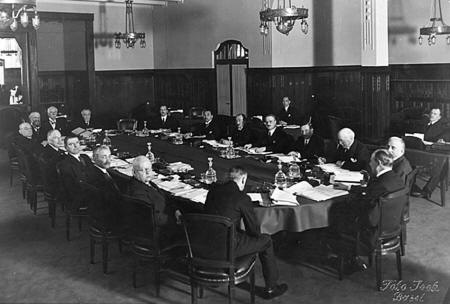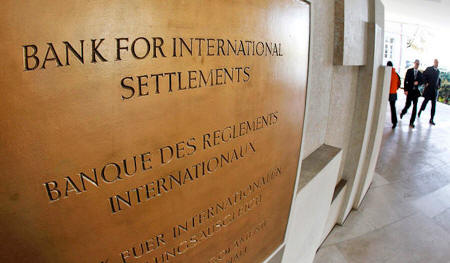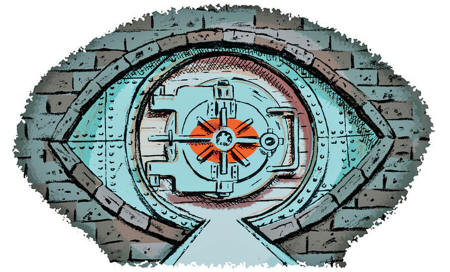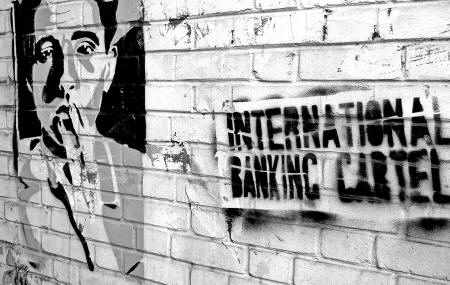|

by Devon Douglas-Bowers
October 09, 2015
from
GlobalResearch Website
|
Devon DB is a 23
year old independent writer and researcher and is the
Politics/Government Department Chair of the Hampton
Institute.
He can be contacted
at devondb[at]mail[dot]com.
Note that this
article is being published
as a three-part
series on
Occupy.com |
Part 1

The Bank for International Settlements (BIS)
is an organization that is shrouded in mystery, mainly due to the
fact that the majority of people don't even know of its existence.
According to the BIS itself, the main
purpose of the Bank is,
"to promote the cooperation of
central banks and to provide additional facilities for
international financial operations" and "act as trustee or agent
in regard to international financial settlements entrusted to it
under agreements of the parties concern." [1]
This means that the BIS is to have the
central banks work with one another to facilitate international
operations and to oversee any international financial settlements.
The Bank has a Board of Directors, which,
"may have up to 21 members,
including six ex officio directors, comprising the central bank
Governors of Belgium, France, Germany, Italy, the United Kingdom
and the United States.
Each ex officio member may appoint
another member of the same nationality. Nine Governors of other
member central banks may be elected to the Board." [2]
BIS also has a management wing in the
form of a General and Deputy General Manager, both of whom are
responsible to the board and supported by Executive, Finance, and
Compliance and Operational Risk Committees. [3]
However, its purpose has changed and evolved over the decades,
however, it has always been a club for central bankers, yet in many
ways it can aid some countries more than others.

How it Started
The origins of the BIS lie in the United
States, specifically New York City.
The individuals involved were
international bankers who, despite past differences,
"worked together to establish a
world financial order that would incorporate the federal
principle of the American central banking system." [4]
Specifically among them were people such
as,
"Owen D. Young, J. Pierpont Morgan,
Thomas W. Lamont, S. Parker Gilbert, Gates W. McGarrah, and
Jackson Reynolds, who, in conjunction with the Federal Reserve
Bank of New York, sought to extend the principle of central bank
cooperation to the international sphere." [5]
Before delving any further into the
creation of the Bank, it is necessary to examine some of the more
notable of these individuals to better understand why they would be
involved in the creation of an international bank.
Owen D. Young was already in good with the US government as
he,
"with the cooperation of the
American government and the support of GE, organized and became
chairman of the board of the Radio Corporation of America" and
"in subsequent years he engineered a series of agreements with
foreign companies that divided the world into radio zones and
facilitated worldwide wireless communication" [6]
Young had a strong belief that global
radio service and broadcasting were important for the advancement of
civilization.
In 1922, Young became chairman of
General Electric, and along with GE President Gerard Swope,
"urged closer business-government
cooperation and corporate self-regulation under government
supervision." [7]
During the 1920s, Young became involved
in international diplomacy as the foreign affairs spokesman for the
Democratic Party.
At the behest of then-Secretary of
State, Charles Evan Hughes, Young and Charles Dawes,
a banker, were recommended to the Allied Reparations Commission in
order to deal with the breakdown in Germany's reparations payments
following the First World War.
The Commission resulted in
the Dawes Plan which allowed for,
"Germany's annual reparation
payments would be reduced, increasing over time as its economy
improved; the full amount to be paid, however, was left
undetermined. Economic policy making in Berlin would be
reorganized under foreign supervision and a new currency, the
Reichsmark, adopted." [8]
Young viewed improving the world
financial structure as important to "the very survival of capita"
[9]
John Piermont Morgan, Jr. was already ensconced in the
world of international banking, having inherited the JP Morgan
Company from his father.
During World War One, the House of
Morgan worked hand-in-hand with the British and French governments,
engaging in a number of tasks such as floating loans for the two
countries, handling foreign exchange operations, and advising
officials of each respective country. [10]
Both these individuals were heavily involved in politics and banking
therefore had a personal interest in the creation of a global bank.
It should be noted, this fits into the
US government's own policies as they wanted to,
"[keep] aloof from the political
entanglements in Europe while safeguarding vital American
interests by means of unofficial observers or participants."
[11]
The Federal Reserve also was interested
in the creation of the BIS as it would,
"[promote] both the ascendancy of
New York City in world banking and the reconstruction of a
stable and prosperous Europe able to absorb American exports."
[12]
This idea of an international bank
didn't occur in a vacuum.
The creation of the bank,
"was inextricably tied to the
problem of German reparations in the context of Germany's
overall debt burden during the 1920s." [13]
A slowdown in international lending to
Germany began in 1928 as markets became extremely worried about the
internal politics of the Weimar Republic.
Due to the breakup of a center coalition
government and the Social Democrats needing support from right-wing
parties, the political situation began to fall apart with,
"government stability [being]
threatened whenever budget debates exposed the basic social
divide of unemployment insurance and increased industrial
taxation on the one hand versus spending austerity and tax cuts
on the other." [14]
The budget problems came on the heels of
the Reparations Committee having determined that Germany's total
reparations came to $33 billion, which was twice the size of the
country's total economy in 1925.
As long as foreign capital kept coming
into Germany, things were fine, however as was aforementioned, that
situation changed in 1928.
Between February 1929 and January 1930, negotiations were made to
reschedule Germany's reparations payments.
"These negotiations were initiated
by central bankers and private actors, who were the first to
link problems in the capital market with the need to reorganize
Germany's financial obligations." [15]
Thus, it should be no surprise that many
of the main individuals involved in the creation of the BIS were
central bankers or engaged in international affairs/finance to some
extent.

Part 2

The idea for an international bank had
already been explored to some extent by people such as John
Mayard Keynes, [16] however the idea truly
took off during the Young Conference in 1929 when the Allies were
attempting to deal with Germany's reparations debts for World War
One.
Belgian delegate Emile Franqui
bought up the possibility of having a settlement organization to
administer the reparations agreement and the very next day,
Hjalmar Schacht, president of the Reichsbank and chief German
representative at the conference, presented a proposal to establish
such an organization to as a direct financier of global economic
development and trade.
The bank would act as a lender to the
German central bank in case the Germany currency weakened and the
government found itself unable to make the reparations payment.
In addition, it would give steps for how
to proceed in the case of German default as if,
"Germany did not resume payments
within two years, the BIS would propose revisions collectively
for the creditor governments (which would only go into effect
with their approval)" and "the bank was responsible for
surveillance and informing the creditor countries about economic
and financial conditions in Germany." [17]
While the US State Department was
concerned with having a settlement as State Department,
"economic adviser Arthur N. Young
observed, 'a final reparations settlement' would 'promote both
political and economic stability in Europe, and thus tend to be
of advantage to the United States,"
...the US government as a whole didn't
want any type of linkage between reparations and war debts due to
the fact that because each of the Allied nations was demanding
reparations from Germany large enough to cover the debts it owed to
the US, having such a linkage would mean that,
"Germany's refusal or inability to
pay that amount would put Washington in the position of having
to agree to a debt reduction or bear the opprobrium and suffer
the consequences of opening the door to financial chaos."
[18]
However, several other countries had
their own interests as well in the creation of the BIS.
The French Prime Minister, Raymond
Poincare, promised the French public that the reparations would
cover the country's debts to both the US and Britain as well as
cover the war damages. France was also interested in reaching an
agreement on German debts as they were developing trade
interdependence with the Germans and stability was needed.
[19]
The British wanted to use the BIS as a means to ensure that the
Germans would pay on their debts as scheduled.
The Bank of England itself supported the
creation of the BIS,
"because of its potential role in
stabilizing the position of the pound in the international
monetary system. Britain's relatively small gold reserves made
it difficult to defend the pound without international monetary
cooperation and the willingness of smaller powers to hold
foreign exchange as reserves instead of gold." [20]
At the meeting in Baden, Germany in
October 1929 to draw up the final plans for the BIS saw the heavy
presence of US finance in the form of Melvin Traylor of the
First National Bank of Chicago and Federick Reynolds of the
First National Bank of New York.
There, the two nominated Gates W.
McGarrah, chairman of the board of the New York Reserve Bank for
the officer of President.
Later, his assistant,
"Leon Fraser, a legal counselor at
Gilbert's reparations office, the Young conference, and Baden,"
[21] would become president of the Bank in
1935.
When the Bank of England expressed anger
and that the European public wouldn't find American domination of
the Bank acceptable, they were effectively told that if they wanted
American participation in the BIS it would have to be on American
terms.
However, they did agree to appoint
Pierre Quesnay of the Bank of France as the general manager of
the BIS.
The Bank was officially founded on May
17, 1930.

A Rocky Beginning
The role of the BIS quickly changed as
with the onset of the Great Depression, it was unable to,
"play the role of lender of last
resort, notwithstanding noteworthy attempts at organizing
support credits for both the Austrian and German central banks
in 1931" and due to the Depression, the issue of reparations was
off the table due to Germany's inability to pay.
The problem was further compounded when
countries such as Britain and the US began to devalue their
currencies (i.e. print more money) and the BIS attempted numerous
times to end the exchange rate instability by restoring the gold
standard,
"the BIS had little choice but to
limit itself to undertaking banking transactions for the account
of central banks and providing a forum for central bank
governors to help them maintain contact." [22]
During the Second World War, all
operations were suspended for the duration of the conflict, yet the
situation became rather dicey for the Bank once the guns stopped
firing.
Immediately after World War Two, the global economic landscape had
massively changed and thus a new system was needed.
In July 1944 over 700 delegates from the
Allied nation met in Mount Washington Hotel in Bretton Woods, NH for
the United Nations Monetary and Financial Conference which,
"agreed on the creation of the
International Monetary Fund (IMF) and an International Bank for
Reconstruction and Development (BRD), which became part of the
World Bank," [23] where the IMF would pay
attention to exchange rates and lend reserve currencies to
nations in debt.
A new global currency exchange system
was created in where all currencies were linked to the US dollar and
in exchange the US agreed to fix the price of gold at $35/ounce.
All of this meant that there would be no need for currency warfare
or manipulation. This proved a threat to the BIS as if the IMF was
to be the center of this new global financial order, what need would
there be for the BIS?
Wilhelm Keilhau, a member of the
Norwegian delegation, even went so far as to propose a notion to
eliminate the BIS.
However, the Bank was to continue as
several other European nations noted its importance to the financial
matters of the European continent and soon the move to eliminate the
Bank was rescinded.
Matters were stable until the 1960s and
'70s as while the
Bretton Woods system of "free
currency convertibility at fixed exchange rates" coincided with a
massive increase of international trade and economic growth, cracks
began to show as the British currency was weak and, more
importantly, the gold parity on the US dollar was straining due to,
"an insufficient supply of gold and
from the weakening of the US balance of payments." [24]
However, the Bretton Woods system
collapsed on August 1971; however the system of 'managed floating'
was created in its place which allowed for flexibility of exchange
rates within certain parameters.
Later in the 1970s, the situation became all the more dire due to
the creation of OPEC and the subsequent rise in oil prices and the
Herstatt Bank failure.
The
Herstatt Bank was central in
processing foreign exchange orders (people exchange currencies, such
as trading in dollars for yen) and when German regulators withdrew
the bank's license forcing the bank to close up shop on June 26,
1974.
Meanwhile,
"it was still morning in New York,
where Herstatt's counterparties were expecting to receive
dollars in exchange for Deutsche marks they had delivered",
[25]
...and when Hersttat's clearing bank
Chase Manhattan refused to fulfill the orders by freezing the
Herstatt account, it caused a chain of defaults.
It was this problem that led to the
creation, in conjunction with the G-10 countries and Switzerland, of
the
Basel Committee on Banking Supervision
in which the goal was to set the global standard for bank regulation
and to provide a forum for bank supervisory matters.
Yet, this newly created stability was short-lived as in the 1980s
and '90s saw serious economic problems involving Latin America and
Asia.
Oil prices quadrupled in November 1973, leading to stagflation, an
increase in balance of payment imbalances, and major shocks in
international banking. The Euro-currency markets were growing as
they began to be utilized by OPEC countries more and more as the
oil-producing nations invested in European money markets, greatly
increasing the money European banks had and thus could lend.
Thus, the
European Coal and Steel Community
began loaning money to developing nations at a faster and faster
peace and while this was largely beneficial to the world economy at
the start,
"it also implied that the
international banking system was faced with an increase in
country risk," [26] as many of the countries
that were being loaned to were getting more and more into debt.
This concerned then-BIS Economic Advisor
Alexandre Lamfalussy who warned of a threat of a crisis and
was specifically focused on credit, saying in a 1976 speech that
from,
"[looking at]… the continuous growth
of credits, the spread of risks to a large number of countries,
and the change in the nature of credits - I draw the conclusion
that the problem of risks has become a very urgent one."
[27]

Part 3
While real interest rates (the
difference between yearly interest rates on savings and inflation
rates) were negative in the 1970s, meaning that borrowers lost a
percentage of every dollar they loaned, allowed for an increase in
credit, it quickly came to a halt in 1979 as
the US Federal Reserve tightened US
monetary policy which led to an increase in debts which many Latin
American countries were unable to pay off.
The BIS was worried about debt that matured in less than a year as
by early 1982, such debt would amount to half of Mexico's and
Argentina's debt respectively.
On August 12, 1982, Mexico alerted the
US that its financial reserves were exhausted. This prompted the BIS
to work to get financial assistance to Mexico in the form of loans,
as the Mexican government negotiated with
the IMF.
Specifically, the BIS,
"offered a US$ 925 million loan,
backed by the G10 central banks and the Bank of Spain" and both
the US Federal Reserve and Treasury "matched this with an equal
amount, so that a total of US$ 1.85 billion was made available
for an initial period of three months." [28]
While there were some last-minute
problems, Mexico eventually accepted the loan and made a promise to
pay it back,
"[consisting] of a gold pledge by
the Bank of Mexico and advance claims on future revenues of the
Mexican state oil company Pemex." [29]
The first loan was paid out on August
30, 1982.
However, the loans were tied to the Mexican government enacting
austerity measures. [30]
This had serious effects as the cutback
in public spending,
"set back many development programs,
including poverty alleviation programs" [31]
and the overall economic effects harmed "especially the lower
and middle classes.
For Mexican workers, real wages in
1986 were at virtually the same level they had been at in 1967;
for many, a generation of economic progress had been wiped out
by the 'lost decade' of the 1980s." [32]
In the late 1990s in Asia, a new crisis
would emerge.
There were extremely robust GDP rates in
the Asian markets, ranging from,
"more than 5 percent in Thailand to
8 percent in Indonesia. This achievement continued a pattern
existing since the early 1980s. Rapid growth was fueled by high
rates." [33]
However, the growth began to slow down
in 1996, which,
"[reflected] slower growth of demand
in the region's principal export markets, a slowdown in the
global electronics industry, and competition from Mainland
China." [34]
This slowdown led to an increase in
deficit rates, especially with Thailand, whose deficits grew eight
percent of GDP.
In an attempt to prevent fluctuations in
the Thai currency, the baht, the government tied the value of the
baht to a basket of foreign currencies, heavily leaning on the US
dollar. However, because the dollar was gaining strength, the
strength of the baht also grew, making the export of goods more
difficult.
Thailand, as well as Indonesia, the Philippines, and Malaysia
devalued their currencies 25 to 33 percent in the middle of 1997 and
when Taiwan began to devalue its currency, it led to a speculative
currency attack on Hong Kong the in which people sold off their Hong
Kong dollars, expecting them to fall in value.
This caused the Hong Kong stock market
to crash in October 1997 while at the same time the South Korean won
was weakening in value. From there the crisis grew to global
proportions and spread to a number of countries such as Russia and
Jakarta.
Thailand as well as South Korea and Indonesia went so far as to
request assistance from the IMF, which the IMF granted of course,
but only in exchange for brutal austerity measures.
Much of this led to violence and even
deaths in Indonesia and protests in South Korea. [35]
What is most interesting about the crisis is how the leaders of some
of the affected countries spoke about it.
Dr. Mahathir Bin Mohamad, the
former Prime Minister of Malaysia, said in a speech on September 26,
2008 that,
"in 1997-98 American hedge funds
destroyed the economies of poor countries by manipulating their
national currencies."
It should be noted that this isn't a
simply 'blame America' attitude as Dr. Mohamad is,
"recognized as an authority on the
role of hedge funds in financial crises, given his experience
managing the Asian currency crisis as it engulfed his nation."
[36]
The Reserve Bank of Australia,
"produced two reports in 1999 on the
potentially destructive role of highly leveraged institutions
such as hedge funds."
The reports claimed that,
"hedge funds contributed to the
instability of its exchange rate in 1998, and it describe how
hedge funds can have a destabilizing impact on not only the
currencies of emerging economies but also on currencies such as
the Australian dollar which has the eighth largest global
trading volume." [37]
In a paper written in early 1999 after
the crisis ended, William R. White, then-Economic Adviser and
Head of the Monetary and Economic Department at the Bank for
International Settlements, wrote that,
"Many Asian-Pacific authorities
(including representatives from Australia, Hong Kong and
Malaysia) feel strongly that hedge funds set out systematically
to destabilize their currencies and their financial markets.
However, other evidence is less
compelling in support of this hypothesis and, even if accepted,
would not necessarily lead to the conclusion that such funds
should be regulated." [38]
So he is not only denying the evidence
that not only have Dr. Mohamad produced, but also the Reserve Bank
of Australia produced, but effectively saying that even if he did
accept the information, so what?
However, years later, in a turn of the
ironic, White had warned of the global crisis as he and his team had
been paying attention to the growing US real estate bubble and they,
"criticized the increasingly
impenetrable securitization business, vehemently pointed out the
perils of risky loans and provided evidence of the lack of
credibility of the rating agencies." [39]
He started warning people back in 2003,
"[imploring] central bankers to
rethink their strategies, noting that instability in the
financial markets had triggered inflation, the 'villain' in the
global economy." [40]
White retired from the BIS on June 30,
2008 with his advice having been ignored.
This was due to the fact that the Federal Reserve was attempting to,
"artificially prop up those markets
[of bad debt and worthless assets] and keep those assets trading
at prices far in excess of their actual market value"
[41] which led to them providing "$16 trillion to
domestic and foreign banks in the form of secret loans and
bought mortgage-backed securities that were in reality,
completely and totally worthless", [42]
...as well as the fact that many of the
people on the board of directors at the Federal Reserve also had
connections to corporations that received bailout money.
Even still, after the financial crisis seemed to be over, the BIS
was sounding the alarm about debt, in June 2010 the organization,
"delivered a stern message to
central banks and governments that keeping interest rates low
for too long, or failing to act quickly to cut budget deficits,
could sow the seeds for the next crisis." [43]
Earlier that year, the organization was
warning of a sovereign debt crisis and noted that,
"Drastic austerity measures will be
needed to head off a compound interest spiral, if it is not
already too late for some." [44]
It seems that from the austerity
measures that have been enacted in Europe and the US, the call has
been heeded.
The question is this:
how much devastation will this have
and will it result in a 'lost generation' such as in 1980s
Mexico?
Notes
-
Roger Auboin, The Bank for
International Settlements, 1930-1955, Princeton University,
https://www.princeton.edu/~ies/IES_Essays/E22.pdf
-
Bank for International
Settlements, Board of Directors,http://www.bis.org/about/board.htm
-
Bank for International
Settlements, Management of the BIS,
http://www.bis.org/about/officials.htm
-
Frank Costigliola, "The Other
Side of Isolationism: The Establishment of the First World
Bank, 1929-1930," The Journal of American History 59:3
(1972), pg 602
-
Ibid, pg 603
-
Steven Schoenherr Home Page,
Owen D. Young,
http://www.sunnycv.com/steve/ar/dd5/young.html
-
Ibid
-
US State Department, The Dawes
Plan, the Young Plan, German Reparations, and Inter-allied
War Debts,
https://history.state.gov/milestones/1921-1936/dawes
-
Costigliola, pg 605
-
Martin Horn, "A Private Bank At
War: J.P. Morgan & Co. and France, 1914-1918," Business
History Review 74:1 (2000), pg 86
-
Costigliola, pg 603
-
Ibid
-
Beth A. Simmons, "Why Innovate?
Founding the Bank for International Settlements," World
Politics 45:3 (1993), pg 370
-
Simmons, pg 375
-
Simmons, pg 377
-
J. Keith Horsefield,
International Monetary Fund 1945-1965 Twenty Years of
International Monetary Cooperation, vol. 1 Chronicle
(Washington D.C.: International Monetary Fund, 1986)
-
Simmons, pg 383
-
Costigliola, pg 610
-
Simmons, pgs 384-385
-
Simmons, pg 389
-
Costigliola, pg 616
-
Bank for International
Settlements, BIS Archive Guide,http://www.bis.org/about/arch_guide.pdf
-
Adam Lebor, Tower of Basel (New
York: Public Affairs, 2013) pg 87
-
Bank for International
Settlements, BIS Archive Guide,http://www.bis.org/about/arch_guide.pdf
-
Gregana Koleva, "Icon of
Systemic Risk Haunts Industry Decades After Demise,"
American Banker, http://www.americanbanker.com/bankthink/bankhaus-herstatt-icon-of-systemic-risk-1039312-1.html
(June 23, 2011)
-
Piet Clement, Ivo Maes, "The BIS
and the Latin American Debt Crisis of the 1980s," National
Bank of Belgium, Working Paper 247, December 2013, pg 3
-
Ibid, pg 4
-
Ibid, pg 17
-
Ibid
-
Paul Lewis, "Mexico to Receive
$1.85 Billion In Loans," New York Times, August 31, 1982
(http://www.nytimes.com/1982/08/31/business/mexico-to-receive-1.85-billion-in-loans.html)
-
Bhuvan Bhatnagar, Aubrey C.
Williams, eds. Participatory Development and the World Bank:
Potential Directions for Change,
http://www-wds.worldbank.org/external/default/WDSContentServer/WDSP/IB/1999/10/21/000178830_98101903552081/Rendered/PDF/multi_page.pdf
(October 31, 1992), pg 103
-
Robert M. Buffington, Don M.
Coerver, Suzanne B. Pasztor, Mexico Today: An Encyclopedia
of Contemporary History and Culture (Santa Barbara, CA:
ABC-CLIO, 2004), pg 137
-
Barry Eichengreen, Understanding
Asia's Financial Crisis, Saint John's University, https://www.csbsju.edu/Documents/Clemens%20Lecture/lecture/Book98.pdf
(November 2, 1998)
-
Ibid
-
PBS, Timeline of the Crash,
http://www.pbs.org/wgbh/pages/frontline/shows/crash/etc/cron.html
-
Stephen J. Brown, "The Role of
Hedge Funds in Financial Crisis," The EconoMonitor, October
20, 2008
(http://www.economonitor.com/blog/2008/10/the-role-of-hedge-funds-in-financial-crisis/)
-
Hedge Funds, Hedge Funds
Studies, http://www.fundshedge.co.uk/hedgefundsreports.htm
-
Bank For International
Settlements, Mr. White discusses the Asian crisis and the
Bank for International Settlements,
http://www.bis.org/review/r990331a.pdf
-
Beat Balzi, Michaela Schiessl,
"The Man Nobody Wanted To Hear: Global Banking Economist
Warned Of Coming Crisis," Der Spiegel, July 8, 2009
(http://www.spiegel.de/international/business/the-man-nobody-wanted-to-hear-global-banking-economist-warned-of-coming-crisis-a-635051.html)
-
Ibid
-
John Wallace, "The Financial
Crisis and the Federal Reserve," News Blaze, September 27,
2008
(http://newsblaze.com/story/20080927140845tsop.nb/topstory.html)
-
Bernie Sanders, The Fed Audit,
http://www.sanders.senate.gov/newsroom/press-releases/the-fed-audit
(July 21, 2011)
-
Brian Blackstone, "International
Finance: BIS Warns Countries About Risks of Debt," Wall
Street Journal, June 29, 2010
-
Ambrose Evans-Pritchard,
"Sovereign Debt Crisis At 'Boiling Point,' Warns Bank for
International Settlements," The Telegraph, April 8, 2010
(http://www.telegraph.co.uk/finance/economics/7564748/Sovereign-debt-crisis-at-boiling-point-warns-Bank-for-International-Settlements.html)
|







